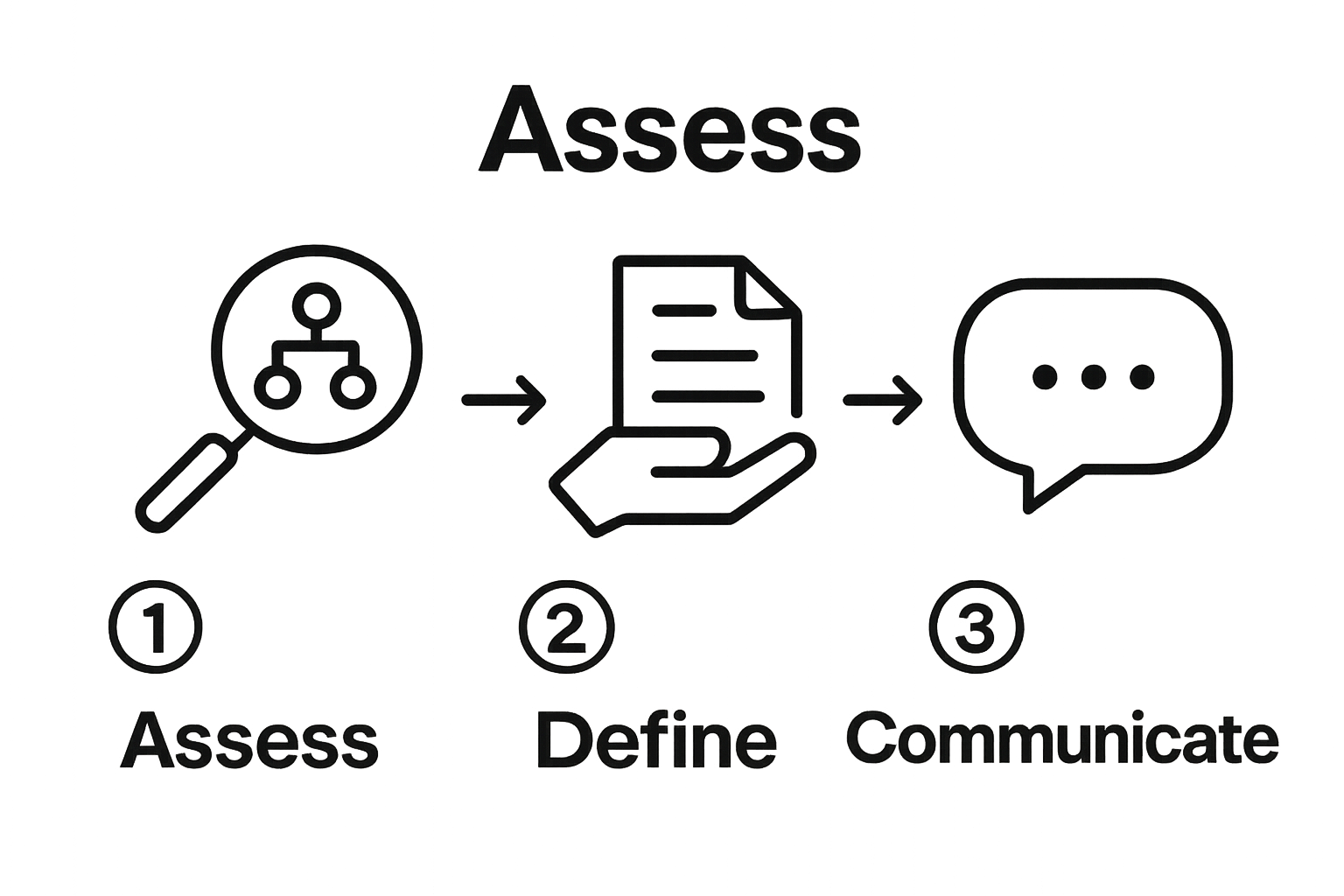Family governance sounds complicated and formal, especially when you hear that families who adopt structured review cycles show much higher long term resilience and adaptability. Most people picture endless meetings and a mountain of paperwork. Yet the real surprise is that structured family governance can actually simplify life and spark stronger connections, making even the largest family ventures feel more unified and future ready.
Table of Contents
- Step 1: Assess Your Family’s Governance Needs
- Step 2: Define Roles And Responsibilities Clearly
- Step 3: Establish Effective Communication Channels
- Step 4: Create Decision-Making Frameworks
- Step 5: Implement Regular Review And Adaptation Processes
Quick Summary
| Key Point | Explanation |
|---|---|
| 1. Assess family governance needs | Conduct an assessment of family dynamics and financial objectives to inform a tailored governance framework. |
| 2. Clearly define roles and responsibilities | Create a family charter outlining each member’s contributions to prevent misunderstandings and ensure accountability. |
| 3. Establish effective communication channels | Implement a structured communication framework to facilitate transparency and trust among family members. |
| 4. Create structured decision-making frameworks | Develop a decision-making matrix to categorize choices and ensure collaborative, transparent processes. |
| 5. Implement regular review processes | Establish systematic assessments of the governance framework to ensure ongoing adaptability and effectiveness. |
Step 1: Assess Your Family’s Governance Needs
Structuring family governance begins with a comprehensive assessment of your unique family dynamics, financial landscape, and long term objectives. This critical first step helps create a tailored governance framework that reflects your family’s specific needs, values, and strategic vision.
Start by gathering key family stakeholders for an open and transparent discussion about governance expectations. This initial conversation should explore multiple dimensions of your family’s financial and interpersonal ecosystem. Focus on understanding each member’s perspectives, concerns, and aspirations regarding wealth management, generational transition, and collective decision making.
Critical Assessment Areas
Evaluate your family’s current communication patterns, investment philosophies, and existing wealth management structures. Consider how decisions are currently made and identify potential gaps or inefficiencies in your present approach. Mapping out these elements provides crucial insights into designing a governance model that can adapt and evolve with your family’s changing needs.
Your assessment should encompass several fundamental domains:
- Family composition and generational complexity
- Current wealth management strategies
- Existing communication channels and decision making processes
- Long term financial and legacy objectives
- Individual and collective risk tolerances
To conduct a robust assessment, engage professional family governance consultants who can provide objective insights and structured evaluation methodologies. These experts can help facilitate nuanced conversations and uncover underlying dynamics that might not be immediately apparent.
Consider creating a comprehensive family governance questionnaire that allows each member to confidentially share their perspectives. This approach ensures every voice is heard and provides a structured mechanism for collecting detailed input. The questionnaire should cover topics like investment preferences, communication expectations, wealth transfer philosophies, and personal career aspirations.
Successful completion of this step means developing a clear, documented understanding of your family’s current governance landscape. You should emerge with a holistic view of your family’s financial ecosystem, potential collaboration opportunities, and strategic priorities that will inform subsequent governance design stages.

Remember that governance assessment is not a one time event but an ongoing process. Plan for periodic reassessments as family dynamics evolve, ensuring your governance framework remains responsive and aligned with changing family needs and objectives.
Step 2: Define Roles and Responsibilities Clearly
After completing your initial governance assessment, the next critical step is establishing crystal clear roles and responsibilities within your family’s wealth management framework. This phase transforms your preliminary insights into a structured organizational approach that minimizes potential conflicts and ensures strategic alignment across generations.
Establishing a Governance Framework
Begin by creating a comprehensive family charter that explicitly outlines each member’s roles, decision making authorities, and expected contributions. This document serves as a foundational blueprint for your governance structure, providing transparent guidelines that prevent misunderstandings and establish accountability.
Determine specific positions within your family governance model. These typically include key roles such as:
- Family Council Chair
- Investment Committee Members
- Next Generation Representatives
- Wealth Transition Advisors
- Family Legacy Coordinators
Recognize that role assignments should balance expertise with generational perspectives. Younger family members might bring technological insights and entrepreneurial thinking, while senior members contribute established wisdom and historical context. The goal is creating a dynamic governance ecosystem where multiple perspectives are valued and integrated.
Consider implementing a rotation mechanism for governance roles to ensure continuous engagement and prevent stagnation. This approach allows different family members to develop leadership skills and maintain collective investment in the family’s strategic objectives. Rotation also helps mitigate potential power concentration and encourages broader skill development across generations.
The table below summarizes key family governance roles identified in the article, along with their main responsibilities and the perspective or expertise they typically contribute.
| Role | Key Responsibilities | Typical Perspective/Expertise |
|---|---|---|
| Family Council Chair | Oversee council meetings, coordinate discussions, ensure accountability | Senior leadership, governance continuity |
| Investment Committee Member | Evaluate investment options, recommend strategies | Financial expertise, investment acumen |
| Next Generation Representative | Provide generational insights, participate in planning | Youth perspective, innovation |
| Wealth Transition Advisor | Plan wealth transfer, advise on succession | Estate planning, legal/financial acumen |
| Family Legacy Coordinator | Preserve family values, manage legacy initiatives | Historical context, cultural stewardship |
Document each role’s specific responsibilities with extraordinary clarity. Define not just functional duties but also expected communication protocols, decision making thresholds, and performance expectations. Your documentation should include detailed job descriptions that outline:
- Specific decision making authorities
- Reporting requirements
- Performance evaluation metrics
- Term lengths for specific positions
- Succession planning guidelines
Successful role definition means creating a flexible yet structured governance model where every family member understands their unique contribution.
 The ultimate verification is achieving consensus around these roles, with each participant feeling both empowered and accountable.
The ultimate verification is achieving consensus around these roles, with each participant feeling both empowered and accountable.
Remember that role definition is not a static process. Plan for periodic reviews and adjustments as family dynamics evolve, ensuring your governance structure remains responsive and aligned with changing family goals and individual capabilities.
Step 3: Establish Effective Communication Channels
Effective communication serves as the fundamental backbone of successful family governance. After defining roles and responsibilities, creating robust communication channels becomes paramount in maintaining transparency, trust, and collaborative decision making across generations.
Designing Communication Infrastructure
Implement a structured communication framework that accommodates various family member preferences and technological capabilities. According to research on family governance, regular and transparent communication mechanisms are critical for maintaining family unity and strategic alignment.
Establish multiple communication platforms to ensure inclusivity and accessibility. This might include a combination of digital and in person channels such as secure online collaboration tools, quarterly family assemblies, annual retreats, and dedicated communication portals. The goal is creating an ecosystem where every family member feels heard and informed.
Key communication channels should include:
- Quarterly family council meetings
- Annual strategic planning retreats
- Secure digital communication platforms
- Formal and informal networking opportunities
- Transparent financial reporting mechanisms
Developing Communication Protocols
Create comprehensive communication guidelines that outline expectations, frequency, and communication etiquette. These protocols should define how information will be shared, who has access to specific types of information, and the mechanisms for raising concerns or proposing strategic discussions.
Consider implementing a tiered communication approach that matches information sensitivity with appropriate sharing mechanisms. Confidential financial details might require more restricted communication channels compared to general family updates. Develop a clear hierarchy of information sharing that respects both transparency and privacy.
Technology plays a crucial role in modern family communication. Invest in secure, user friendly digital platforms that allow real time collaboration, document sharing, and strategic planning. These tools should be intuitive enough for all generations to use comfortably while maintaining robust security protocols.
Successful communication channel establishment means creating a dynamic, responsive system where family members feel both informed and empowered. Verification of effectiveness includes regular feedback mechanisms, high engagement rates in family discussions, and a demonstrable sense of collective understanding about family objectives and strategies.
This checklist table outlines key actions to verify the effectiveness of your family governance communication channels, making it easy to track completion and ongoing maintenance.
| Verification Step | Description | Completion Status |
|---|---|---|
| Regular engagement in family discussions | Monitor participation rates in meetings and communication platforms | [ ] |
| Routine feedback collection from family members | Collect feedback to identify issues or improvements in communication | [ ] |
| Periodic review of communication infrastructure | Schedule ongoing evaluations of tools and protocols to ensure adaptability to family needs | [ ] |
| Clear sense of collective understanding achieved | Assess whether all members feel informed about objectives and strategies | [ ] |
| Use of secure and accessible digital platforms | Verify that digital tools are usable by all generations and maintain data security | [ ] |
Remember that communication is an evolving process. Schedule periodic reviews of your communication infrastructure, remaining flexible and willing to adapt as family dynamics and technological capabilities continue to change.
Step 4: Create Decision-Making Frameworks
Decision making represents the most critical mechanism within family governance, transforming strategic intentions into actionable outcomes. A well designed decision making framework ensures systematic, transparent, and collaborative processes that balance individual perspectives with collective family objectives.
Structuring Collaborative Decision Processes
Develop a comprehensive decision making matrix that categorizes choices based on complexity, financial impact, and strategic significance. This framework should differentiate between routine operational decisions and transformative strategic choices, establishing clear pathways for resolution.
Establish explicit decision making tiers that reflect the varying levels of complexity and potential impact. These tiers might include:
- Operational Decisions (Low Impact)
- Financial Transactions
- Strategic Investment Choices
- Generational Wealth Transfer Strategies
- Long Term Legacy Planning
Implement a voting and consensus mechanism that provides equitable representation while preventing decision paralysis. Consider weighted voting systems that balance generational perspectives, expertise levels, and strategic contributions. The goal is creating a democratic yet efficient decision making process that respects both collective wisdom and individual expertise.
Conflict Resolution and Governance Mechanisms
Integrate robust conflict resolution protocols within your decision making framework. These mechanisms should provide clear pathways for addressing disagreements, ensuring that divergent perspectives can be constructively explored without disrupting family unity. Develop a structured mediation process that includes neutral third party facilitation when internal resolution proves challenging.
Document all decision making processes with extraordinary precision. Your governance documentation should outline specific details including:
- Voting thresholds
- Decision escalation procedures
- Minority opinion protections
- Transparent reporting requirements
- Periodic review mechanisms
Successful framework creation means establishing a dynamic system that can adapt to changing family circumstances while maintaining consistent strategic integrity. The ultimate verification is achieving decisions that reflect collective family interests, demonstrate transparent reasoning, and generate broad stakeholder support.
Remember that decision making frameworks are living documents. Schedule periodic reviews to ensure the approach remains responsive to evolving family dynamics, emerging financial opportunities, and generational shifts in perspective and expertise.
Step 5: Implement Regular Review and Adaptation Processes
A dynamic family governance structure requires continuous refinement and strategic adaptation. This critical step ensures your governance framework remains responsive to changing family dynamics, emerging financial landscapes, and generational shifts in perspective and expertise.
Establishing Systematic Review Mechanisms
Design a comprehensive review process that systematically evaluates your family governance model across multiple dimensions. These periodic assessments should examine the effectiveness of existing communication channels, decision making frameworks, roles, and overall strategic alignment. According to family governance research, organizations that implement regular strategic reviews demonstrate significantly higher long term resilience and adaptability.
Implement a structured annual review cycle that encompasses comprehensive evaluation of your governance infrastructure. This process should include:
- Comprehensive performance assessments
- Stakeholder feedback collection
- Strategic objective realignment
- Governance framework effectiveness evaluation
- Next generation engagement metrics
Creating Adaptive Governance Mechanisms
Develop flexible governance protocols that allow for seamless modifications without disrupting core family strategic objectives. This approach requires creating a constitutional framework for your family governance model that includes clear mechanisms for proposing, evaluating, and implementing structural changes.
Establish a dedicated governance adaptation committee responsible for monitoring emerging trends, assessing potential improvements, and recommending strategic modifications. This committee should represent diverse generational perspectives, ensuring that both established wisdom and innovative thinking contribute to the evolution of your governance approach.
Integrate technological tools and digital platforms that facilitate transparent, data driven review processes. Utilize collaborative software that allows real time documentation, tracking of governance modifications, and comprehensive historical record keeping. These technological solutions enable more precise performance measurement and strategic refinement.
Consider implementing a continuous learning approach that treats governance as an evolving ecosystem. Encourage family members to share insights, propose improvements, and participate actively in the review process. This collaborative method transforms governance from a static structure into a dynamic, responsive framework.
Successful implementation means creating a governance review process that is both rigorous and adaptable. Verification includes demonstrable improvements in family communication, strategic alignment, and the ability to navigate complex financial and interpersonal challenges.
Remember that governance adaptation is not about constant radical change, but thoughtful, incremental refinement that preserves core family values while remaining responsive to emerging opportunities and challenges.
Unlock Stronger Family Governance with Real Solutions
Is your family struggling to define clear roles, maintain strategic alignment, or find effective communication channels? Building lasting family governance is hard. You need more than just a blueprint—you need a living network of proven tools and shared expertise. The challenges described in this article, like assessing your family’s unique needs, creating transparent decision-making frameworks, and adapting to evolving dynamics, require up-to-date insights and trusted partners you can rely on.

Take the next step to lasting family success by joining the community at Future Family Office. Explore our comprehensive directory of family office service providers and read in-depth thought leadership articles focused on governance best practices. Connect with experienced professionals, access real-world resources, and bring clarity to your family’s wealth journey—act now so your governance keeps pace with your ambitions.
Frequently Asked Questions
What are the key steps to assess my family’s governance needs?
To assess your family’s governance needs, gather key stakeholders for honest discussions about expectations, evaluate communication patterns, investment strategies, and existing decision-making processes. Consider areas like family composition, financial objectives, and risk tolerances to gain a holistic view of your governance landscape.
How can I define roles and responsibilities within family governance?
Define roles and responsibilities by creating a family charter that outlines each member’s contributions, decision-making authorities, and expected communication protocols. Key roles may include Family Council Chair, Investment Committee Members, and Wealth Transition Advisors, ensuring balance between expertise and generational perspectives.
What communication channels should be established for family governance?
Establish multiple communication channels to ensure inclusivity, such as quarterly family meetings, annual retreats, and secure digital platforms. Develop communication protocols that outline expectations regarding frequency, etiquette, and how to raise concerns, ensuring all members feel heard.
How often should we review and adapt our family governance framework?
A family governance framework should be reviewed annually to assess its effectiveness, gather stakeholder feedback, and realign strategic objectives. Incorporating a dedicated governance adaptation committee can facilitate ongoing evaluation and ensure the framework remains responsive to evolving family dynamics.
Recommended
- How can we Prepare the Now Generation of Family Business? – Future Family Office
- How can we Prepare the Now Generation of Family Business? – Future Family Office
- Why Do Families Give? The 5 Spheres And Motivations Around Philanthropy – Future Family Office
- Randel Carlock: Family Businesses or Family Enterprises? – Future Family Office




